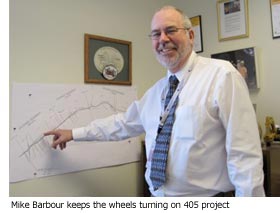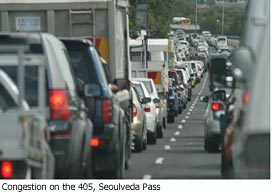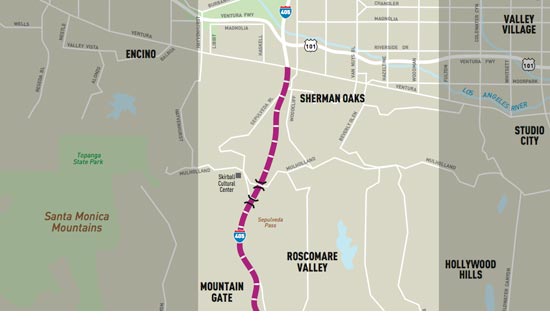Meet Metro’s man on the 405 project
January 12, 2010
It wasn’t that long ago that Mike Barbour was in the midst of rocket attacks as an Air Force reservist working on projects like rebuilding bombed out bridges or constructing temporary aircraft hangars in Iraq.
Now he’s under another kind of pressure, of the diplomatic and logistical variety, as Metro’s top guy on the 405 Sepulveda Pass widening project—a multi-jurisdictional, three-year undertaking that will create a 10-mile northbound carpool lane between the Santa Monica (10) and the Ventura (101) freeways.
Along the way, it will have a profound impact on commuters traveling one of the nation’s most heavily traveled freeways, and also will significantly affect the surrounding neighborhoods and businesses. It’s a huge job that requires deft coordination among agencies and departments and a straight-shooting approach to communicating with the area’s well-informed–and often vocal–residents.
Enter Mike Barbour.
Barbour, 56, who joined Metro just a year ago, figures it was his unique set of highway design and construction experiences—and not his time in a war zone—that made him the right man for the job of overseeing every facet of the complex project.
Still, it couldn’t hurt.
At his first meeting with representatives of homeowner groups, he encountered a contentious crowd but ended up making a positive impression.
“He kept his cool,” says Milton Miller, past president of the Bel-Air Association and the homeowner group’s representative on the Community Advisory Committee that is working with Metro on the 405 project. “He acted like a gentleman. He seems calm and measured, and pays attention. My impressions are positive. He didn’t try to hog the presentation and say, ‘This is about me.’”
Now, as eight weeks of night work begin on the 405, setting the stage for construction to begin in earnest in March, Barbour finds himself at the center of a high profile and high stakes enterprise that will be closely watched across the region.
The inaugural construction phase will change life as we know it on the already congested 405. “It’s a big deal…The people that drive this, that live there, haven’t been impacted and now they’re going to be impacted.”
The impact hits on Wednesday, Jan. 13, at 7 p.m., when, weather permitting, crews will start delineating new, narrower lanes on the freeway to accommodate a construction zone.
 The first full freeway closure is set to occur after midnight, in the early morning hours of Jan. 14, with all lanes scheduled to reopen by 6 a.m. [Updated 1/13/10: The start of work on the 405 is being delayed for a second night because of rain. Learn more here.] Updates also are being posted on Twitter. In addition, Metro has expanded its community relations staff on the project and has established a hotline for public inquiries, (213) 922-3665.
The first full freeway closure is set to occur after midnight, in the early morning hours of Jan. 14, with all lanes scheduled to reopen by 6 a.m. [Updated 1/13/10: The start of work on the 405 is being delayed for a second night because of rain. Learn more here.] Updates also are being posted on Twitter. In addition, Metro has expanded its community relations staff on the project and has established a hotline for public inquiries, (213) 922-3665.
In dealing with the community, Barbour says, the important thing is to stick to the facts in the project plan. “All the people on the Westside understand what’s going on,” he says. “You need to be very straightforward.”
At monthly meetings with the Community Advisory Committee, Barbour says he tackles “every issue under the sun,” including such questions as: “Are you closing my off ramp? Are you affecting me? Can emergency equipment get through?” (For that last question, he brought in police and fire representatives to explain how they will respond.)
There are also meetings for the community as a whole, such as an open house planned for Jan. 20 at the Westwood Recreation Center.
The project, a partnership of the Los Angeles Metropolitan Transportation Authority (Metro) and the California Department of Transportation (Caltrans), is expected to cost $1.034 billion, with $189.9 million coming from the American Recovery & Reinvestment Act of 2009. The rest will flow from state and other federal sources.
Barbour’s job, which pays $200,000 annually, involves coordinating the work of all agencies with a role in the project—including Caltrans, the city Department of Transportation and L.A. County.
“It’s really trying to knock down the barriers for the contractor (Kiewit Pacific Co.),” says Barbour, whose official title is Executive Officer, Highway Project Management. “One of our main concerns is keeping the project on schedule.”
He’s a true believer in the importance of completing the northbound carpool lane through the Sepulveda Pass and creating an unbroken high-occupancy vehicle route from the Orange County line north to the San Fernando Valley.
“The HOV lane is a really big impact,” he says. “Three hundred thousand people come through there daily.”
Metro estimates that daily carpool commuters could save about 10 minutes a day—50 minutes a week—when the project is completed in 2013. “It’s not a lot for an individual,” Barbour says, “but for 300,000 people—that’s a significant amount of money and time.”
Carpool lanes aren’t just a job for Barbour; they’re a passion.
He says he often grabs a colleague to travel with him so he can take advantage of the carpool lanes on the 105 or 405 as he shuttles between his main office at the Howard Hughes Center near the airport, the job site in Brentwood and Metro’s downtown Los Angeles offices. And when he’s in the carpool lane, “I can just blow by everybody on the 105.” (Get it? He likes carpool lanes.)
Before joining Metro, Barbour, who grew up in Southern California, worked for 8 years as a consultant in the private sector. Earlier, he put in 18 years at Caltrans, including a stint as acting deputy director for design for District 7, which includes Los Angeles and Ventura counties.
If you’ve ever been on the 110/Adams Boulevard HOV lane near downtown Los Angeles, or the Carquinez suspension bridge in Northern California, you know his work.
Before Barbour retired as a major in the Air Force Reserve, he was deployed twice to Iraq—in 2003 and again in 2007. “I wouldn’t trade it for anything,” he says.
Barbour still has a home in Northern California, where he spent much of his career with Caltrans and where his wife works as an attorney. He says he’s looking to buy a place in L.A. soon.
Meanwhile, he’s got lots of 10- and 12-hour days to keep the gears moving on the 405 project. “Everybody wants to get a greener planet,” he says. “But what we’re stuck with is a society where everybody commutes. If you have it, you’ve gotta fix it.”
Posted 1/12/10
—————————————————————————————————————————————–













 405 bridge work causes a stink
405 bridge work causes a stink

